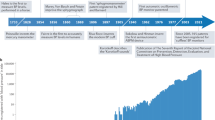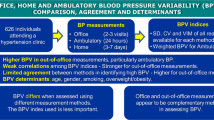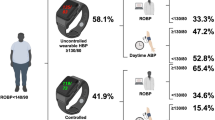Abstract
Blood pressure (BP) measurements taken outside the routine office context may be a useful adjunct strategy to monitor BP. Community-based BP data can also provide estimates of the prevalence of elevated BP. We compared multiple readings taken on different days in pharmacies using an automated BpTRU device during a cardiovascular health programme targeting community-dwelling older adults. Mean systolic (S) and diastolic (D) BP values were compared over time using repeated measures analysis of variance for all participants with at least three separate sets of readings (n=317). BP variability was then examined among four subgroups based on report of antihypertensive medication or no treatment, and normal or elevated SBP at the initial visit (< or ⩾140, or 130 if diabetes reported). Prevalence of elevated BP was compared across visits. Overall, mean SBP decreased between visits 1 and 2 (140.4 vs 137.1 mm Hg; P<0.001). Among participants with normal SBP at the initial visit, SBP did not vary significantly, whether or not antihypertensive treatment was reported. Those with initially elevated SBP experienced a significant decrease between visits 1 and 2, also regardless of treatment status. Prevalence of elevated BP decreased from visits 1 to 2 (55.8 vs 48.9%; P=0.026) and from visits 1 to 3 (55.8 vs 42.9%; P<0.001). Analyses of BP data from a community-based programme using an accurate device showed that initial readings may inflate the population estimate of elevated BP. Findings suggest that more than one set of BP readings measured on different occasions are needed, particularly if the first set is elevated.
This is a preview of subscription content, access via your institution
Access options
Subscribe to this journal
Receive 12 digital issues and online access to articles
$119.00 per year
only $9.92 per issue
Buy this article
- Purchase on Springer Link
- Instant access to full article PDF
Prices may be subject to local taxes which are calculated during checkout


Similar content being viewed by others
References
Chambers LW, Kaczorowski J, Levitt C, Karwalajtys T, McDonough B, Lewis J . Blood pressure self-monitoring in pharmacies: building on existing resources. Can Fam Physician 2002; 48: 1594–1595.
Sullivan SM, Kaczorowski J, Myers MG, Karwalajtys T, Chambers LW . Use of automated blood pressure measurement to reduce white coat response in a pharmacy setting. Canadian Cardiovascular Congress Canadian Hypertension Society (CCC/CHS). 20 October 2007. Quebec City (Poster).
Roubsanthisuk W, Wongsurin U, Saravich S, Buranakitjaroen P . Blood pressure determination by traditionally trained personnel is less reliable and tends to underestimate the severity of moderate to severe hypertension. Blood Press Monit 2007; 12: 61–68.
Nietert PJ, Wessell AM, Feifer C, Ornstein SM . Effect of terminal digit preference on blood pressure measurement and treatment in primary care. Am J Hypertens 2006; 19: 147–152.
Myers MG . Automated blood pressure measurement in routine clinical practice. Blood Press Monit 2006; 11: 59–82.
Beckett L, Godwin M . The BpTRU automatic blood pressure monitor compared to 24-h ambulatory blood pressure monitoring in the assessment of blood pressure in patients with hypertension. BMC Cardiovasc Disord 2005; 5: 18.
Mattu G, Perry T, Wright J . Comparison of the oscillometric blood pressure monitor (BPM-100Beta) with the auscultatory mercury sphygmomanometer. Blood Press Monit 2001; 6: 153–159.
Graves JW, Nash C, Burger K, Bailey K, Sheps SG . Clinical decision making in hypertension using an automated (BpTRU) measurement device. J Hum Hypertens 2003; 17: 823–827.
Culleton B, McKay D, Campbell N . Performance of the automated BpTRU measurement device in the assessment of white-coat hypertension and white-coat effect. Blood Press Monit 2006; 11: 37–42.
Chambers LW, Kaczorowski J, Dolovich L, Karwalajtys T, Hall H, McDonough B . A community-based program for cardiovascular health awareness. Can J Public Health 2005; 96: 294–298.
Campbell NR, Conradson HE, Kang J, Brant R, Anderson T . Automated assessment of blood pressure using BpTRU compared with assessments by a trained technician and a clinic nurse. Blood Press Monit 2005; 10: 257–262.
Karwalajtys T, Kaczorowski J, Chambers L, Levitt C, Dolovich L, McDonough B et al. A randomized trial of mail vs telephone invitation to a community-based cardiovascular health awareness program for older family practice patients. BMC Fam Pract 2005; 6: 35.
Botomino A, Martina B, Ruf D, Bruppacher R, Hersberger KE . White coat effect and white coat hypertension in community pharmacy practice. Blood Press Monit 2005; 10: 13–18.
The Systolic Hypertension in the Elderly Program (SHEP) Cooperative Research Group. Rationale and design of a randomized clinical trial on prevention of stroke in isolated systolic hypertension. J Clin Epidemiol 1988; 41: 1197–1208.
Myers MG, McInnis NH, Fodor GJ, Leenen FHH . Comparison between an automated and manual sphygmomanometer in a population survey. Am J Hypertens 2008; 21 (3): 280–283.
National Center for Health Statistics. http://www.cdc.gov/nchs/data/nhanes/nhanes_05_06/PE.pdf. (section 4.2: Physician protocol). Accessed 12 January 2008.
Report by the Management Committee. The Australian therapeutic trial in mild hypertension. Lancet 1980; 1: 1261–1267.
Millar JA, Isles CG, Lever AF . Blood pressure, ‘white coat’ pressor responses and cardiovascular risk in placebo-group patients of the MRC Mild Hypertension Trial. J Hypertens 1995; 13: 175–183.
Author information
Authors and Affiliations
Corresponding author
Additional information
Supplementary Information accompanies the paper on the Journal of Human Hypertension website (http://www.nature.com/jhh)
Supplementary information
Rights and permissions
About this article
Cite this article
Karwalajtys, T., Kaczorowski, J., Hutchison, B. et al. Blood pressure variability and prevalence of hypertension using automated readings from multiple visits to a pharmacy-based community-wide programme. J Hum Hypertens 23, 585–589 (2009). https://doi.org/10.1038/jhh.2008.163
Received:
Revised:
Accepted:
Published:
Issue Date:
DOI: https://doi.org/10.1038/jhh.2008.163
Keywords
This article is cited by
-
Prevalence of hypertension among travelers and stability of blood pressure control during travel: a cross-sectional descriptive study and prospective cohort study
Tropical Diseases, Travel Medicine and Vaccines (2023)
-
Burden, patterns, and impact of multimorbidity in North India: findings from a rural population-based study
BMC Public Health (2022)
-
Pharmacists’ knowledge of automated blood pressure devices
Journal of Human Hypertension (2022)
-
Hypertension management initiative prospective cohort study: comparison between immediate and delayed intervention groups
Journal of Human Hypertension (2014)
-
Magnitude of the White-Coat Effect in the Community Pharmacy Setting: The MEPAFAR Study
American Journal of Hypertension (2011)



